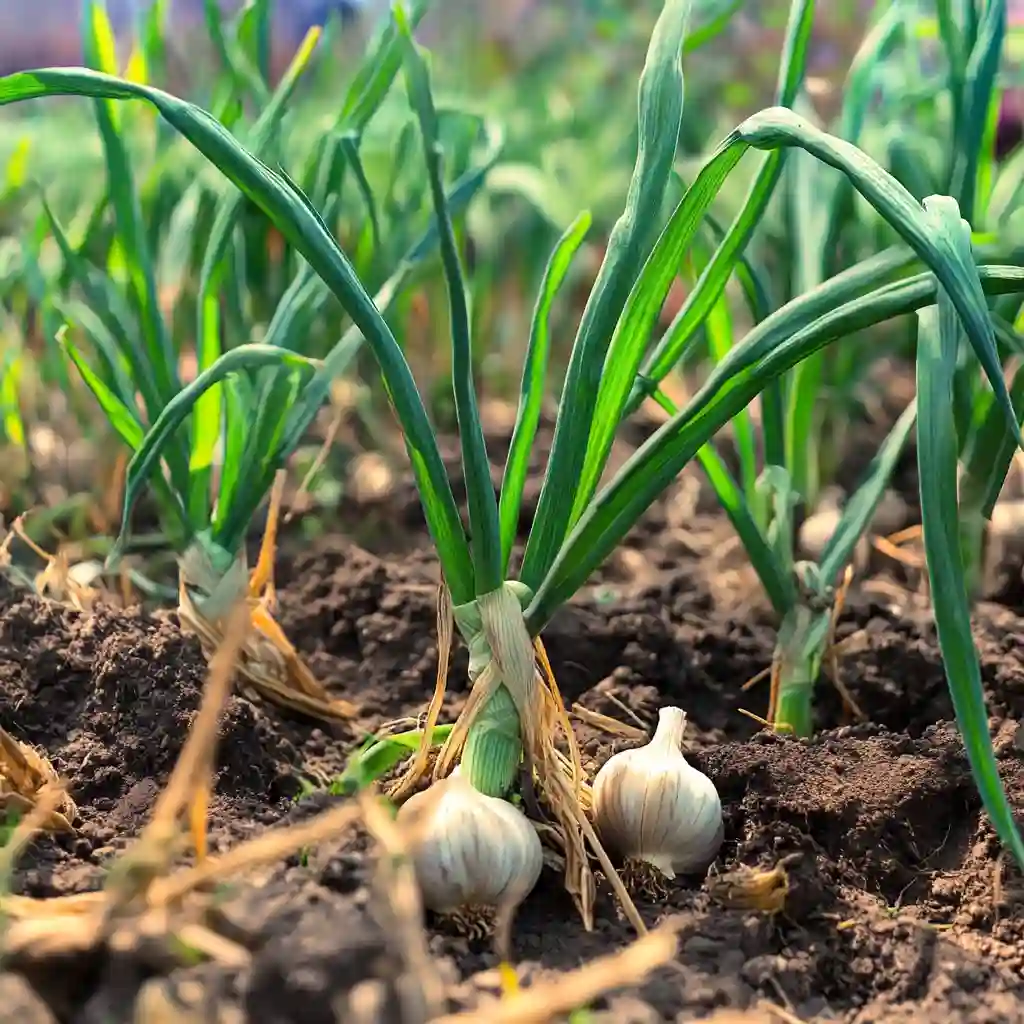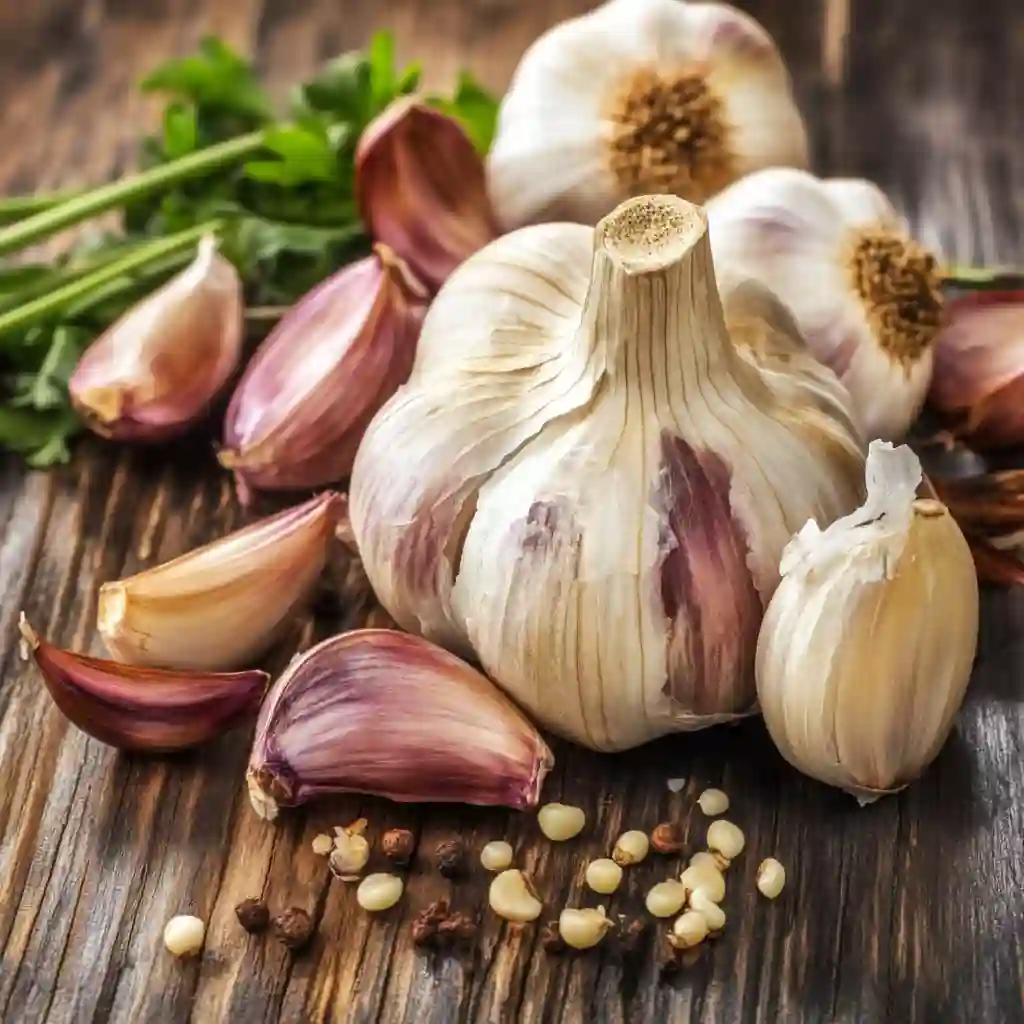Garlic is more than just a kitchen staple — it’s a rewarding and surprisingly simple plant to grow right in your own backyard. In fact, once you learn how to plant, grow, and harvest garlic, you’ll wonder why you ever settled for store-bought bulbs. With minimal space, time, and gardening experience, you can produce robust, flavorful garlic perfect for roasting, sautéing, pickling, or gifting.
Whether you dream of fragrant garlic braids hanging in your kitchen or want to boost your self-sufficiency with homegrown crops, this guide walks you through each essential step. From selecting the right variety to storing your harvest like a pro, we’ll help you master the garlic-growing process.
Choosing Your Garlic Type
Before planting your garlic, it’s important to understand the two main types: hardneck and softneck. Each has its own flavor profile, storage life, and growing characteristics — and choosing the right type can make a big difference in your success and satisfaction.
🧄 Hardneck Garlic (Allium sativum var. ophioscorodon)
- Flavor: Bold, complex, sometimes spicy or “hot”
- Structure: Produces a stiff central stalk (called a scape) with a single row of large cloves around it
- Storage Life: Shorter — typically 2 to 4 months
- Climate Preference: Best suited for colder climates
- Bonus: Scapes are edible and delicious — perfect for stir-fries or pestos
Hardneck garlic is popular with chefs and foodies for its intense flavor. However, because it doesn’t store as long, you’ll want to use it sooner rather than later after harvesting.
🧄 Softneck Garlic (Allium sativum var. sativum)
- Flavor: Milder, more subtle garlic taste
- Structure: No central stalk; produces multiple layers of smaller, irregular cloves
- Storage Life: Excellent — often up to 9 months or more
- Climate Preference: Thrives in milder, warmer climates
- Bonus: Perfect for braiding — just like those classic market garlic ropes
Softneck garlic is what you’ll usually find in grocery stores. It’s ideal for gardeners looking to store garlic long-term or try their hand at decorative braiding.
🌱 Expert Tip: Buy seed garlic from local nurseries or reputable suppliers instead of planting supermarket garlic. Grocery garlic is often treated to prevent sprouting and may not be suited to your climate zone.
Timing Your Garlic Planting
When it comes to garlic, timing is everything. Planting garlic at the right time ensures it develops strong roots, forms full heads, and ultimately delivers a bountiful, flavorful harvest. The key factor? Cold weather — garlic needs a chilling period to properly form cloves.
🗓️ Best Time to Plant Garlic
- Fall Planting (Recommended):
- When: 2–4 weeks before your first expected frost
- Why: Fall planting allows garlic to establish roots before winter. Then, it goes dormant and resumes growth in early spring. This leads to larger, more flavorful bulbs by summer.
- Bonus: Nature provides the necessary chill period with no extra effort on your part.
- Spring Planting:
- When: As early as soil can be worked (around the same time as peas or onions)
- Why: Works in milder regions, but spring garlic may not get the chilling it needs to divide properly. The result may be single, onion-like bulbs.
🌿 Pro Tip: Fall is best for most gardeners — especially in temperate or colder climates. But if you missed the fall window, don’t give up! Try spring planting with pre-chilled garlic for decent results.
🌡️ The Chilling Requirement
Garlic requires 4–8 weeks of cold temperatures (ideally between 32–50°F or 0–10°C) for proper bulb formation. This natural vernalization triggers the garlic to split into multiple cloves rather than growing as one solid bulb.
💡 Not sure when your first frost hits? Contact your local Cooperative Extension Office, or use an online frost date calculator based on your zip code.
Preparing Garlic Planting Beds
Garlic may be low-maintenance, but the secret to big, healthy bulbs lies beneath the surface — in soil preparation. Before planting, take time to set your garlic up for success with nutrient-rich, well-structured beds that allow for strong root development and good drainage.
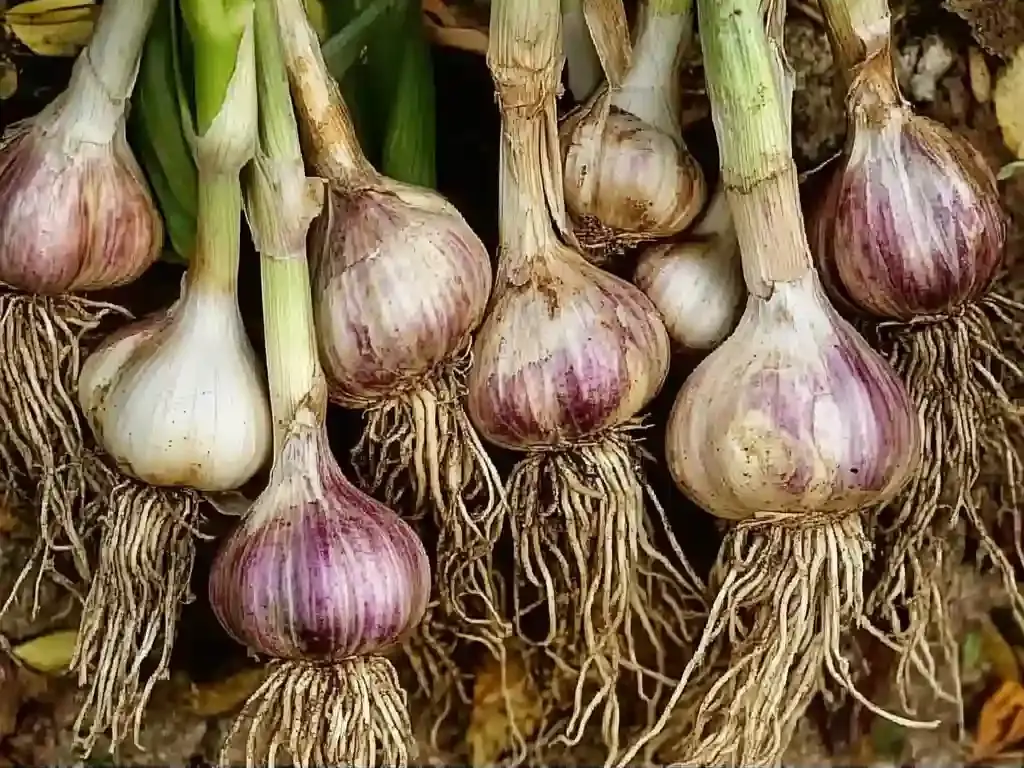
☀️ Sunlight
Garlic needs full sun — at least 6 to 8 hours per day. Choose a garden spot that’s not shaded by trees or tall plants, especially during fall and early spring when sunlight is precious.
🌱 Soil Requirements
- Soil Type: Loose, crumbly, and well-draining
- Soil pH: Slightly acidic to neutral (ideal range: 6.0 to 7.0)
- Soil Texture: Sandy loam is best, but you can amend clay-heavy soil with compost to improve drainage
🌿 Why this matters: Garlic doesn’t like wet feet. Heavy or compacted soils can cause rotting, especially in colder climates with winter moisture.
🌾 How to Prepare Your Garlic Bed
- Clear the Area: Remove weeds, rocks, and any leftover plant debris.
- Loosen the Soil: Use a garden fork or tiller to loosen the top 8–10 inches of soil.
- Add Organic Matter: Mix in 3–4 inches of compost or well-aged manure. This boosts soil fertility and moisture retention.
- Apply Balanced Fertilizer: Use an all-purpose fertilizer like 10-10-10 (NPK) at the rate recommended on the label.
- Level and Rake Smooth: Create a fine, level seedbed that’s easy to plant into.
🧪 Bonus Tip: If you’re serious about growing garlic every year, consider doing a soil test through your local extension office. It tells you exactly what amendments your soil needs for peak garlic performance.
Planting Your Garlic
Now for the fun part — getting your garlic in the ground! Unlike many garden veggies, garlic is grown from cloves, not seeds. Each clove you plant will grow into a full head of garlic, so choose and handle them with care.
🧄 How to Prep Garlic for Planting
- Break Apart the Bulbs:
- Gently separate the cloves from the bulb just before planting.
- Leave the papery skins on each clove intact.
- Avoid damaging the flat basal plate (this is where roots form).
- Pick the Best Cloves:
- Choose the largest, healthiest cloves for planting.
- Discard any that are soft, shriveled, or moldy.
- Save small cloves for cooking — they tend to produce weaker plants.
🌱 How to Plant Garlic Cloves
- Planting Depth:
- In mild climates: 1–2 inches deep
- In cold climates: 3–4 inches deep to protect from frost
- Spacing:
- Space cloves 4–6 inches apart
- Space rows 10–12 inches apart
- Orientation:
- Flat end down, pointy end up — just like a tiny spear aiming for the sky
🍂 Mulching After Planting (Especially for Fall)
- Apply 4–6 inches of weed-free mulch after planting
- Ideal mulch options: straw, shredded leaves, grass clippings
- Mulch helps regulate soil temperatures, suppress weeds, and retain moisture
🌿 Expert Tip: Mark your garlic rows with labels or stakes — they’ll go dormant in winter and you don’t want to accidentally dig them up come spring!
Once your cloves are planted and tucked in for the season, the next phase is all about gentle tending and timely care.
Caring for Garlic as It Grows
Garlic is a surprisingly low-maintenance crop, but giving it the right care at the right times makes all the difference between scrawny bulbs and a bumper harvest. Whether you’ve planted in fall or spring, a little attention goes a long way.
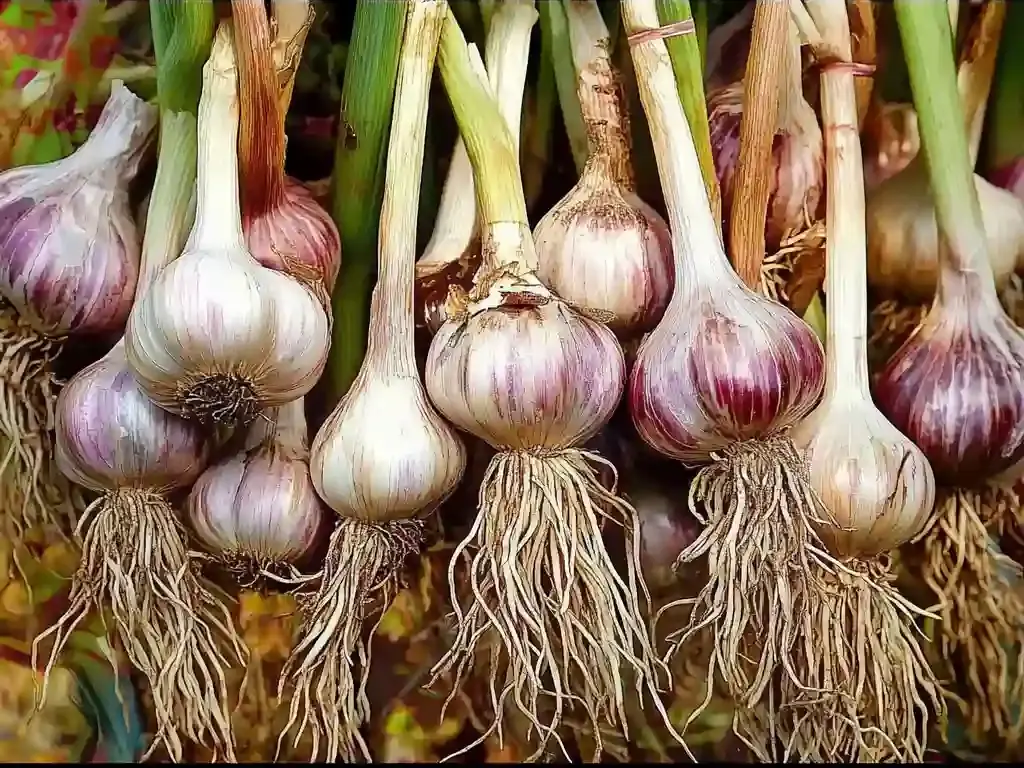
🌱 Early Growth: What to Expect
- Fall-planted garlic will usually sprout before winter — just a few green shoots.
- During winter, garlic goes dormant underground while roots continue to develop.
- Growth resumes in early spring, once soil warms up.
💧 Watering Garlic
- Garlic needs 1 inch of water per week, including rainfall.
- Water deeply but avoid soggy soil — overwatering can lead to rot.
- As harvest time nears (more on that soon), stop watering completely to help the bulbs harden and cure.
🍂 Mulch Management
- In spring, when shoots grow 6+ inches tall, gently pull mulch back to let the soil warm up.
- Keep some mulch around to suppress weeds and retain moisture.
🍽️ Feeding Garlic
- Fertilize again in early spring with a balanced fertilizer or compost.
- Apply side-dressings of nitrogen-rich fertilizer (like fish emulsion or blood meal) every 3–4 weeks until early summer.
🌿 Tip: Compost tea is another great organic option to feed garlic during its active growing phase.
🌿 Remove Scapes (Hardneck Only)
- In early summer, hardneck garlic will send up scapes — curly flower stalks.
- Cut them off once they curl once or twice.
- This redirects energy into growing larger bulbs.
- Bonus: Garlic scapes are edible! They’re delicious sautéed, grilled, or made into pesto.
❌ Weeds and Pests
- Weed regularly — garlic hates competition.
- Garlic repels many pests naturally, but watch for:
- Cutworms
- Onion thrips
- Leafminers
🧪 For a non-toxic approach, try neem oil, insecticidal soap, or row covers to protect young plants.
🍄 Fungal Diseases to Watch
- Botrytis blight, downy mildew, or white rot may appear as leaf spots or yellowing.
- Good air circulation, proper watering, and crop rotation help prevent most fungal issues.
Harvesting and Storing Garlic
The big moment has arrived — harvest time! But knowing when and how to harvest garlic is just as important as growing it. With a few careful steps, you can cure and store your garlic for months of fresh, flavorful use.
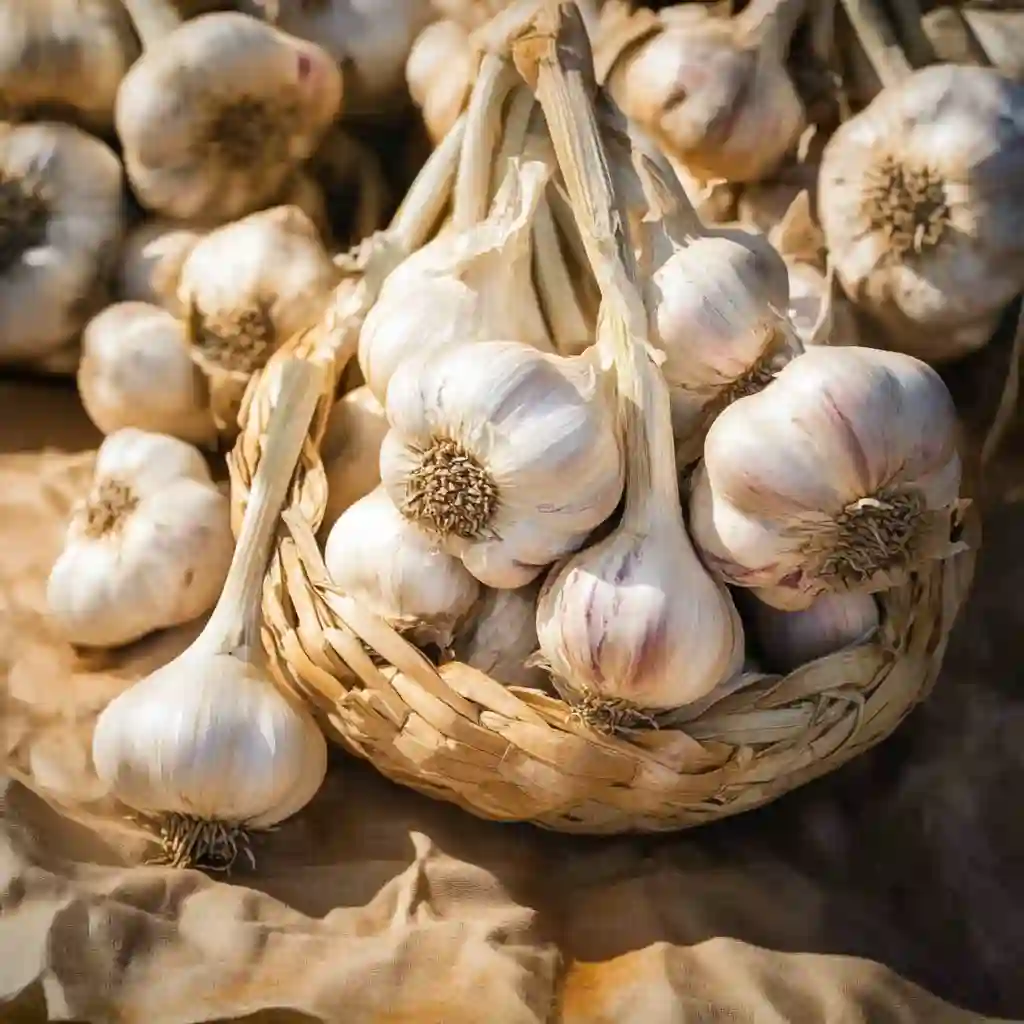
🧄 When to Harvest Garlic
Garlic is usually ready for harvest mid to late summer — July through September, depending on your climate and planting time.
Here’s how to tell it’s ready:
- Leaves yellow and start to dry, beginning with the lower ones
- Top leaves fall over, but the stems are still mostly firm
- The bottom 3–4 leaves have turned brown, while the upper leaves are still green
⛏️ Pro Tip: Don’t wait until all the leaves are dead — overripe bulbs will split open and won’t store well.
🧑🌾 How to Harvest Garlic
- Loosen soil carefully with a fork or spade — don’t pull the bulbs by hand!
- Lift bulbs gently, keeping the stalks and roots attached
- Shake off excess soil — do not wash them
🌬️ Curing Garlic for Storage
Curing is essential to dry and harden the garlic so it stores well.
- Hang bulbs in bunches (with stems intact) or lay them out in a single layer
- Choose a dry, shaded, well-ventilated space like a garage, porch, or shed
- Let them cure for 2 to 4 weeks until the wrappers are papery and stems are fully dry
🌿 Bonus: Softneck garlic is great for braiding before storing or gifting.
🧊 Long-Term Garlic Storage
- After curing, cut off roots and stems (leave 1 inch stem for hardnecks)
- Store bulbs in a cool, dark, dry place
- Ideal temperature: 32–50°F (a fridge or cellar works well)
- Avoid airtight containers — garlic needs to breathe
- Never store with moisture, or it could mold
Properly stored softneck garlic can last up to 9 months, and hardneck varieties for 3–5 months.
🌱 Set aside your best bulbs for replanting next season — and your garlic-growing cycle continues!
Your homegrown garlic is now ready to elevate every meal with homegrown flavor — from roasted cloves to zesty sauces and pestos.
Conclusion
Growing garlic at home is one of the most satisfying — and flavorful — gardening adventures. With just a little planning and patience, you can plant, grow, and harvest garlic that rivals anything from the store. Whether you prefer the strong kick of hardneck varieties or the long-lasting, milder softnecks, you now have the knowledge to:
- Choose the right garlic for your climate and taste
- Time your planting for the biggest yields
- Prepare rich, well-draining garden beds
- Plant and mulch for strong root growth
- Water, feed, and protect your garlic as it grows
- Harvest and cure bulbs like a pro
- Store garlic to enjoy it for months (and replant your best bulbs!)
Garlic is a crop that keeps on giving — from the kitchen to the garden and back again. So grab your cloves, prep your beds, and get ready for a harvest full of flavor.

